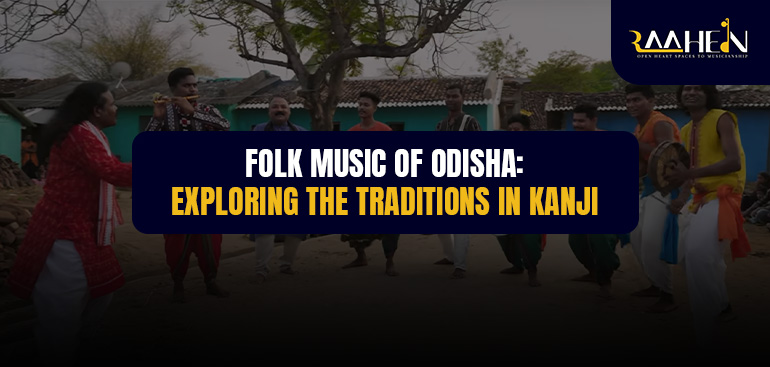Odisha, a culturally rich state on the eastern coast of India, holds within its landscapes an extraordinary musical legacy. The folk music of Odisha is a mirror to the life, festivals and stories of its people – rooted in agricultural rhythms, devotional narratives and tribal expressions. Unlike the heavily documented classical traditions of Odissi music, Odisha’s folk music thrives in villages, tribal hamlets and local festivals where music is a way of life, not performance.
“KANJI is more than a song; it’s a celebration of connection through music and food. Just as Kanji travels from one home to another, our music carries the festive pulse of Odisha to listeners everywhere.”
— Shefali Khanna, RAAHEIN Gharana
Read her full thoughts on LinkedIn: Read the full post
Each district in Odisha offers a distinct musical identity. Instruments like the mardal, mahuri, and dhol accompany songs that mark seasonal changes, weddings, harvests, and religious festivities. The music is earthy, percussive, and melodic, deeply tied to oral traditions passed down across generations. These songs not only preserve history and myth but also provide spiritual nourishment and social cohesion.
In the midst of this rich cultural backdrop, RAAHEIN Gharana’s latest folk revival project presents a standout tribute: “KANJI.”
KANJI is more than a song – it is a celebration of life, food, and musical storytelling. Part of RAAHEIN Gharana’s “Rhythmic Roots” series (featuring 28 songs from 28 Indian states), this track brings Odisha’s native instruments, dialects, and festive spirit to the forefront in a way rarely seen in India’s mainstream music.
Inspired by Tradition: The Cultural Significance of Kanji In Odisha, Kanji isn’t just a fermented rice dish. It represents warmth, generosity, and communal spirit—a dish that travels from one household to another during festivals and village gatherings. This symbolism is carried beautifully into the song, where Kanji becomes a metaphor for how music, like food, brings people together.
The song draws inspiration from the Rekhpur and Mandel communities of Kalahandi district, whose vibrant traditions, daily rituals, and festive spirit helped shape the narrative. Their participation and cultural expressions form the heart of the composition, allowing us to authentically portray the Brahmin, Goud, Bhandari, Luhura, and Kumbhar identities through music and storytelling.
Voices from the Soil: The Local Artists Behind Kanji KANJI features 12 artists, 9 regional and 3 contemporary blending the raw energy of grassroots music with fresh, modern perspectives. The blend is seamless. The local vocalists bring authenticity in pronunciation, intonation, and emotional cadence that only native voices can.
Their singing doesn’t merely narrate; it immerses listeners in the scent of red soil, the taste of homemade food, and the sounds of Odisha’s heartlands.
Table of Contents
Instruments That Speak Odisha’s Language
What sets KANJI apart is its faithful inclusion of seven traditional Odia folk instruments, each carrying cultural memory and sonic uniqueness:
- Dhol – A double-sided drum that drives high-energy rhythms during festivals and folk dances.
- Flute – A melodic wind instrument that adds a soulful, earthy texture to the composition.
- Ghudka – A rustic, handheld percussion instrument, often played during tribal rituals and celebrations.
- Ghumra – A war-drum-like tribal instrument, typically tied around the neck and played while dancing; powerful and ceremonial in tone.
- Jhanj – Metal clappers or cymbals used in devotional songs and community gatherings for rhythmic accents.
- Nissan – A large kettledrum used in temples and tribal settings to signal processions or sacred events.
- Tasha – A sharp-pitched kettle drum that adds urgency, grandeur, and ceremonial energy to the ensemble.
Together, these instruments don’t just accompany the music—they embody it, each evoking moments like weddings, harvests, religious processions, and community dance rituals, weaving an immersive soundscape that’s unmistakably Odia.
A Visual and Sonic Celebration of Odisha Shot on location in Kalahandi, the music video for KANJI is as authentic as the song itself. From capturing real villagers preparing Kanji to spontaneous community dance circles, the visuals reflect an untouched, dignified portrait of Odisha’s rural life.
The entire video is steeped in color, movement, and joy – a living documentation of folk practices that continue to thrive.
Rhythmic Roots: A Nationwide Folk Revival KANJI is part of RAAHEIN Gharana’s larger mission to create 28 regional songs representing each Indian state. The initiative highlights the diversity of India’s lesser-known folk instruments and the artists behind them.
By bringing together rural performers and urban producers, RAAHEIN Gharana ensures that these traditions are not just archived but celebrated, performed, and given a global platform.
Why Kanji Matters
- It gives visibility to underrepresented Odia folk instruments.
- It empowers local musicians through professional audio-video storytelling.
- It tells a universal story of community, joy, and cultural pride.
- It creates space for collaboration between rural traditions and indie folk artists.
Where to Listen
You can watch the full music video of KANJI on YouTube. The track is also available for streaming on Spotify, Apple Music, Gaana and other platforms under RAAHEIN Gharana.
Folk music in India isn’t disappearing – it’s evolving. And thanks to thoughtful, immersive efforts like RAAHEIN Gharana’s Rhythmic Roots, songs like KANJI are not only keeping traditions alive but giving them a new voice for new generations.
Let this be more than a listen. Let it be a return to your roots – through food, rhythm, and collective memory.

